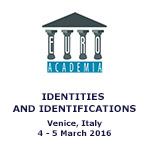Euroacademia Conferences
 Europe Inside-Out: Europe and Europeanness Exposed to Plural Observers (9th Edition) April 24 - 25, 2020
Europe Inside-Out: Europe and Europeanness Exposed to Plural Observers (9th Edition) April 24 - 25, 2020 Identities and Identifications: Politicized Uses of Collective Identities (9th Edition) June 12 - 13, 2020
Identities and Identifications: Politicized Uses of Collective Identities (9th Edition) June 12 - 13, 2020 8th Forum of Critical Studies: Asking Big Questions Again January 24 - 25, 2020
8th Forum of Critical Studies: Asking Big Questions Again January 24 - 25, 2020 Re-Inventing Eastern Europe (7th Edition) December 13 - 14, 2019
Re-Inventing Eastern Europe (7th Edition) December 13 - 14, 2019 The European Union and the Politicization of Europe (8th Edition) October 25 - 26, 2019
The European Union and the Politicization of Europe (8th Edition) October 25 - 26, 2019 Identities and Identifications: Politicized Uses of Collective Identities (8th Edition) June 28 - 29, 2019
Identities and Identifications: Politicized Uses of Collective Identities (8th Edition) June 28 - 29, 2019 The European Union and the Politicization of Europe (7th Edition) January 25 - 26, 2019
The European Union and the Politicization of Europe (7th Edition) January 25 - 26, 2019 7th Forum of Critical Studies: Asking Big Questions Again November 23 - 24, 2018
7th Forum of Critical Studies: Asking Big Questions Again November 23 - 24, 2018 Europe Inside-Out: Europe and Europeanness Exposed to Plural Observers (8th Edition) September 28 - 30, 2018
Europe Inside-Out: Europe and Europeanness Exposed to Plural Observers (8th Edition) September 28 - 30, 2018 Identities and Identifications: Politicized Uses of Collective Identities (7th Edition) June 14 - 15, 2018
Identities and Identifications: Politicized Uses of Collective Identities (7th Edition) June 14 - 15, 2018
Borders Objects: Dissolution or Exacerbation of Identity
-
-

-
Presentation speakers
- Sabine Du Crest, University Bordeaux Montaigne, France
- Download presentation
Abstract:
From the very beginning of the Early modern period, objects were designed that embedded various layers of contact between Europe and extra-European worlds. At the methodological crossroads of objects biography, material culture and transculturality, this paper will investigate so-called border objects, artifacts made in Europe with natural or artificial objects coming from the antipodes like mounted shells or Chinese porcelain. The value of context or visual horizon in the making of the meaning of objects and their ambivalent identity are key issues of this survey. In order to discuss the dissolution or exacerbation of identity that such objects embedded in themselves, this paper will address borderline cases of border objects, at times, kitsch, like a Venetian binding and a cabinet. Borderline because self and otherness are probably much more entangled in such Venetian objects than in the other European cases of border objects. The border objects are entangled objects, therefore, the identity they bear is an entangled identity, global and local at the same time. The Venetian borderline cases of border objects provide a particulary interesting light on this essential point for the definition of such objects and therefore for the question of identity because there is the problem of whether the border objects still exist in border areas as Venice where everything is mixed or hybrid or if people are so accustomed to hybridity as they are able to perceive more subtle differences. The vibration or the fluidity of meaning seems to be the more appropriate answer at the question about identity of border objects and much more in these borderline cases. These Venetian objects are exponentially ambivalent objects whose spatial ambiguity is essential. In this sense and in this context, they are special and performative cases of border objects, evidence of an unstable and ambivalent world.
-
Related Presentations

Californian Exopolis: Hector Tobar's and Tim Z. Hernandez's Literary Interventions
- Katarzyna Nowak-McNeice













